Do you think that fall clean-up is a once-and-done chore, and that’s it for the rest of the season?
Not quite.
Instead, leaves continue to fall throughout autumn in Collin County, TX and smother your turfgrass, leading to turfgrass diseases, thatch build-up, bare spots, increased critter activity, and turf death.
It’s better to keep cleaning your North Dallas lawn until all leaves have finished falling and blowing around for the season.
Learn why your Sachse lawn needs more than one fall clean-up per season in this blog post.
What’s Fall Lawn Clean-Up and Why You Need It More Than Once
At College Fund Landscaping, we provide seasonal leaf clean-up services because it prevents leaves from suffocating the lawn and holding onto moisture.
For example, moisture gets trapped under leaves during the winter months, which causes bare spots on your lawn. These dead spots mean you must sod that area in the spring. And for now, your lawn will not look as good as it did a few months ago.
Allowing leaves to accumulate on your lawn also causes thatch build-up because the leaves won’t break down quickly. And turfgrass roots can’t grow deeply into the soil because of the thatch build-up. Excess thatch has fungal disease pathogens in it as well.
Since leaves don’t come down all at once, you’ll need continual leaf clean-up services to keep your lawn free from these suffocating leaves that can cause thatch build-up and turf diseases.
When our techs visit your property for your seasonal leaf clean-ups, they perform the following tasks:
- The crew will blow all the leaves out of your flower beds, hardscape areas and onto your lawn.
- From there, our techs will put mulching bags on our mowers to collect all the leaves from your yard.
- Our techs will take those bagging attachments to a local recycler who uses the leaves for mulch.
When you invest in our seasonal leaf clean-up services, your lawn will remain healthy and absorb lawn fertilizer, moisture, and fall pre-emergent weed control.
Fungal Diseases: A Hidden Threat to Your Richardson, TX Lawn
In last month’s blog post, “Fungicide Fix: Top North Dallas Turf Diseases and How to Beat Them,” we talked about overwatering your lawn in the fall—especially before a hard freeze that causes fungal diseases to develop.
Likewise, allowing leaves to stay on your lawn throughout the winter traps moisture on your turfgrass that never dries out. This trapped moisture leads to fungal diseases, particularly on lawns prone to diseases. This is another reason we provide regular lawn leaf clean-up services throughout the fall.
Read more: How to Treat Lawn Fungal Diseases In North Texas
You don’t want the following turf diseases on your lawn:
- Brown Patch
- Dollar Spot
- Take-All Root Rot
- Pythium Blight
- Gray Leaf Spot
- Rust
- Slime Mold.
After we clean up your Richardson, TX, lawn from the leaves, you can make an appointment with us for a preventative fungicide application to keep these pathogens from developing into a full-blown disease on your lawn.
The Risk of Turf Death and Bare Spots from Leaf Accumulation
Though dormant, turfgrass needs to breathe and receive sunlight during the winter. Leaving large piles of leaves in your yard will smother the turf, killing it. In the spring, you won’t see a green-up; you’ll see bare spots or thin areas.
If left untreated, weeds will grow in place of turf, meaning you’ll need to hire us to aerate and sod those bare spots.
You can save money and frustration when you continually remove the leaves in the fall instead of having to start rebuilding a green, dense lawn from scratch in the spring.
Allowing leaves to stay on your property throughout the winter causes fungal diseases, thatch build-up, and bare spots. But did you know it also enables rodents to damage your lawn?
When you allow leaves to stay on your lawn, voles, moles, and mice will cruise underneath the leaves and remain unseen until spring. Voles tunneling under your turf will kill it.
While their underground trails will smooth down, voles can still damage your lawn because they eat the grass, including the roots, which leads to more turf death.
Voles will damage your lawn and wreak havoc on your landscape.
You also want to ensure you don’t put leaves against tree trunks or landscaped areas like a volcano because voles will stay hidden under the leaves and travel to your trees and flowerbeds to eat bark, perennials, and flower bulbs.
Get all the leaves up and out of your Plano, TX lawn before it’s damaged by leaf suffocation or rodent behavior.
Summing Up
Lawn clean-up isn’t a once-and-done chore in the fall. Instead, trees let go of their leaves throughout autumn and into early winter. If you allow leaves to accumulate on your lawn, you risk your turfgrass developing a disease, bare spots, rodent activity, and even turfgrass death.
Voles, thatch build-up, and fungal diseases thrive in leaf-covered lawns. Instead, you want to invest in our seasonal leaf clean-up services at College Fund Landscaping.
Why You Need a Landscaping Company to Clean Up Your Lawn This Fall
You’re busy and don’t want to spend your weekends using a leaf blower and a rake to pick up leaves. Instead, hire us at College Fund Landscaping to cover all your fall lawn care needs, including multiple leaf clean-ups.
Contact us today at 972-985-0279 or fill out our contact form to get started with our seasonal leaf clean-up services.
Sources:
IPM.UCanr.edu, Voles (Meadow Mice).
Turf.Umn.edu, Good Question: Do You Really Need to Rake All Those Leaves?



Comments (0)
Thanks for your comment!
Thanks for your feedback! Your comments have been successfully submitted! Please note, all comments require admin approval prior to display.
Error submitting comment!
There is a problem with your comment, please see below and try again.